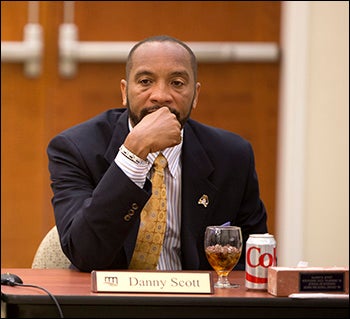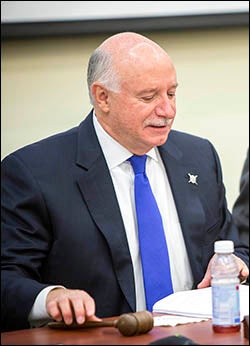Trustees review fiscal sustainability measures, strategic planning
Continuing fiscal challenges were front and center during the regular meeting of the East Carolina University Board of Trustees held July 17-18 at the East Carolina Heart Institute at ECU.
Chancellor Steve Ballard began his report to trustees Friday morning by describing the financial strain.
“It’s been the most difficult (year) of my 10 years – the seventh straight year of major cutbacks,” Ballard said. “We will do everything we can to protect the most vital parts of the university as we try to cope with what seem to be never-ending reductions.”
At the center of the university’s response is a report drafted by the University Committee on Fiscal Sustainability. It builds on the prior work of the Program Prioritization Committee, which assessed all academic programs at the university.

Board members including Danny Scott, pictured above, heard recommendations for fiscal sustainability during a time of severe budget cutbacks for the university.
UCFS members issued 61 recommendations, which were delivered to the chancellor May 1 for review and approval. Ballard adopted all of them, and smaller working groups have been established to develop action plans and best practices for implementation.
Vice Chancellor for Finance and Administration Rick Niswander reported that work on seven items is already under way, with 11 more expected to begin this fall. All recommendations will yield action over the next two to three years. More information about the recommendations is online at https://news.ecu.edu/2014/04/02/a-sustainable-ecu/.
“This is not simply a cost saving device,” Niswander added. “Much of that savings then gets reallocated (toward priority programs).”
Of particular concern is funding for the Brody School of Medicine – two sources of which remain in limbo as the state legislature has not yet approved a budget or appropriations for the university.
“(Brody) is threatened because of state restrictions that tend to remove its financial opportunities every year,” Ballard told board members during his remarks. “One of my goals is to seek permanent state appropriations for this school. It’s a way to stop the year-to-year bloodletting that’s happening (at Brody).”
Efforts to sustain the medical school are ongoing. They range from improving access to patients by adjusting scheduling and billing protocols; to altering how medical faculty are compensated; to a review of every position and program funded by Brody or its clinical practice, ECU Physicians.
“There are a lot of decisions yet to be made but there is progress in all these areas,” said Phyllis Horns, vice chancellor for health sciences.
Infrastructure needs for ECU’s aging facilities were also discussed.
“Repairs and renovations for an older campus are huge,” Ballard said. “We have urgent, immediate needs of $70 million for repairs and renovations. Those needs will get bigger and the state’s ability to help us pay for those things is not keeping up.”
Despite fiscal challenges, the board also looked toward the future during a review of a new strategic plan for the university. The plan focuses on three commitments outlined in ECU’s mission statement – student success, serving the public and achieving regional transformation.

Robert Brinkley, pictured above, was re-elected July 18 for a second term as chairman of the ECU Board of Trustees.
“It really is an aspirational document,” said Interim Provost Ron Mitchelson, who is leading the planning initiative. “We’re going to set the bar high and try to get there – try our best.”
Proposed initiatives to achieve those ends range from attracting more transfer and military students; to developing a school focused on coastal research; to increasing partnerships between the College of Engineering and various health sciences disciplines.
Board members lauded the strategic plan and Board Chairman Robert Brinkley described it as “aspirational but achievable.”
“I think it’s totally unique; it’s very ECU,” said Trustee Carol Mabe. “There’s tremendous clarity and focus of what we’re going to do and how we’re going to do it.”
ECU last produced a strategic plan in 2007. The next steps for the updated plan are final edits and then approval by the Chancellor’s Executive Council, made up of top university administrators.
Other items from the July board meeting included:
- The Board elected officers for the 2014-15 term. Robert Brinkley was re-elected as chairman; Steve Jones, vice chair, and Edwin Clark, secretary, were also re-elected. All will be serving second terms in the positions. ECU Student Government Association President Michael King, a senior, was also sworn in as an ex-officio member.
- The Board voted to approve the purchase of property at 908 Forbes Street from the ECU Real Estate Foundation for $107,800. The property is adjacent to a parking lot at the corner of E. 10th and Evans Streets.
- Staff Senate Chair Mary Schiller presented her organization’s goals for the coming year. The Staff Senate comprises 52 delegates representing 4,000 staff members, said Schiller during the inaugural Staff Senate report to the board.
- The Athletics and Advancement Committee agreed to name various facilities and programs on campus for donors who have given a total or $2.2 million to the university. The largest gift was a $1 million donation from the Harold H. Bate Foundation of New Bern, which paid for the track facility at ECU’s Olympic Sports Complex. Minges Bottling Group of Ayden was also recognized for donating $500,000 toward costs associated with the infield at the track and field facility in the Olympic Sports Complex.
Jeannine Manning Hutson contributed to this report.
